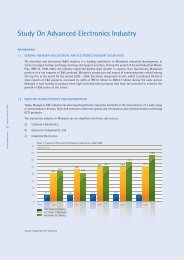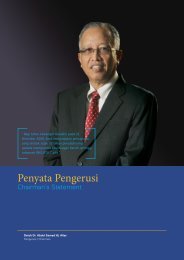Oil and Gas Industry
oil and gas indUstrY - Bank Pembangunan Malaysia Berhad
oil and gas indUstrY - Bank Pembangunan Malaysia Berhad
Create successful ePaper yourself
Turn your PDF publications into a flip-book with our unique Google optimized e-Paper software.
Annual Report 2012 59Deepwater Exploratory• The most critical <strong>and</strong> long lasting potential increase inproduction is set to come from deepwater projects. Atcurrent rates, crude oil output in Malaysia from maturingfields is expected to last only for the next two decades,according to industry website Offshore Technology. This isa low figure compared to Malaysia’s overall current reserveto-productionratio of 28 years.• Offshore plays, ranging somewhere between 200 metres<strong>and</strong> 1,200 metres for deepwater <strong>and</strong> from 1,200 metresonwards for ultra-deepwater, are a vital counterbalance,set to contribute an estimated 30 percent towards thecountry’s total oil production by 2020, according to areport by consultancy Frost & Sullivan. Indeed, so intenseis PETRONAS’ interest in deepwater discoveries that incapital expenditure alone Malaysia is set to see the largestincrease in the region, beating India <strong>and</strong> China withinvestment of US$60 billion over the next five years.• The first producing of these new deepwater projects, is theKikeh field, offshore Sabah. Discovered in 2002, US operatorMurphy <strong>Oil</strong> <strong>and</strong> Petronas Carigali managed to overcomethe complex geology <strong>and</strong> water depths of 1,341 metres,beginning production of 40,000 bopd in August 2007.• As more wells came on stream the output has sinceincreased to 120,000 bopd. Since the Kikeh discovery,other international oil companies have sunk their teeth intoMalaysia’s deepwater prospects. By July 2011, 24 rigs weredrilling in Malaysian waters.• The total number of offshore rigs is expected to grow toapproximately 30 by 2013, with 20 percent of the forecastedwells drilled by 2015 to be in deepwater, according toFrost & Sullivan. Deepwater is the next key frontier forMalaysia. It is established <strong>and</strong> proven that it is very prolificpetroleum system.Revitalization of Mature Assets• The final piece of Malaysia production target jigsaw is expectedto come from the aggressive revitalization of mature fields<strong>and</strong> the use of enhanced recovery techniques. In January2012, Shell <strong>and</strong> PETRONAS signed two, 30-year PSCs that,when combined, are expected to become the world’s largestoffshore Enhanced <strong>Oil</strong> Recovery (EOR) project.• The two projects, worth US$12 billion, are also set tobecome the first to employ sizeable offshore chemicalEOR, with the North Sabah field becoming the first to usealkaline surfactant polymer technology in a horizontal wellenvironment.• The large investment PETRONAS has made to seize theopportunity to maximize domestic output through itsnew RSC model, enhanced oil recovery techniques <strong>and</strong>deepwater exploration has created a buzz with regards tooffshore activity.• PETRONAS is expected to benefit from advances intechnology, both for subsea exploration <strong>and</strong> production,including EOR <strong>and</strong> Malaysia will be able to sustain - <strong>and</strong>possibly increase - current national oil production levels.Offshore Support Vessels (OSV)• Malaysia features a plethora of offshore support vessel (OSV)players, with vessels of all speed <strong>and</strong> size, reflective of thevariety of offshore upstream activities in the country. At thelower end of the value scale, the sector offers a relativelyeasy entry for startup companies wishing to gain a footholdin the promising offshore oil <strong>and</strong> gas industry.• With increasing requirements for deepwater capabilities<strong>and</strong> fiercer competition for contracts with vessels oflower brake horsepower (bph), it is the higher valuevessel owners, together with those that enjoy moregenerous financing terms, that st<strong>and</strong> to gain the mostfrom Malaysia’s deepwater frontier.• The sector took a battering following the 2008 oil pricedrop <strong>and</strong> the global economic downturn. Daily charterrates for OSVs are strongly correlated to the price of oil,the key determinant in upstream operators investmentdecisions, impacting upon the dem<strong>and</strong> for offshoreservices.• The stalling of upstream projects after 2008 wascompounded by an oversupply of OSVs in the run up tothe oil price retreat, as owner-operators exp<strong>and</strong>ed fleets<strong>and</strong> a swathe of new entrants appeared during a bullishmarket for oil that saw a record peak in price in 2008 ofUS$145 per barrel.• The existing PSCs for the Baram Delta oilfield offshoreSarawak <strong>and</strong> the North Sabah development areas were dueto expire by 2019.• However, under the fresh terms, the licences have beenextended until 2040, with the added EOR componentpotentially yielding an increase in average recovery from36 percent to 50 percent, according to Shell.





